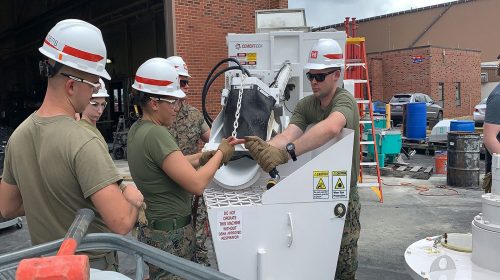Marine Corps Systems Command and 7th Engineer Support Battalion staff joined U.S. Army Corps of Engineers Construction Engineering Research Laboratory (CERL) colleagues last month to test a 3D concrete printing operation with a late model volumetric mixer feeding a 3-in. nozzle. The Champaign, Ill., demonstration was staged to fabricate a field-grade bunker, and followed Marine Corps units’ barrack and bridge structure printing with a 2-in. nozzle assembly.
|
|
| Mustering last month near the University of Illinois, Champaign, Marine Corps Systems Command members prepare for printing via the 3-in. diameter hose and nozzle. The larger diameter nozzle test followed the Marines’ late-2018 demonstration of 2-in. hose and nozzle-based 3D concrete printing at Camp Pendleton in California, 7th Engineer Support Battalion and Sailors plus Naval Mobile Construction Battalion 5 members doing the honors. |
 |
| PHOTOS: Major Kenneth Kunze, Marine Corps Systems Command (Illinois demonstration, top); Lance Corporal Betzabeth Galvan, 1st Marine Logistics Group (California, above). |
While the 3-in. nozzle printing is experimental, notes Megan Kreiger, project lead for the CERL Automated Construction of Expeditionary Structures team, “We are trying to push the technology forward. This is the first time in the world anyone has really tried using these larger bead systems with these larger pumps.” Increasing from a 2-in. to a 3-in. nozzle allows printing of larger structures faster and with less waste, she adds, and sets the table for the team to pursue printing with a 4-in. nozzle during future equipment development.
Along with the 3-in. diameter mix hose and nozzle, the central Illinois 3D concrete printing operation incorporated a continuous volumetric mixer similar to one adopted for the Marine Corps Airfield Damage Repair Kit, notes Captain Matthew Audette, project officer for the Advanced Manufacturing Operations Cell at Marine Corps Systems Command. “That means we don’t have to field a new piece of gear in addition to the printer to make this work,” he observes.
The 7th Engineer Support Battalion Marines plan to build a conventional bunker similar to the 3D-printed version and compare both structures in blast or demolitions testing on a range. They envision a CERL-modeled printing system being operational within a few days of deployment to a forward operating base. Compared to present protocol, it would quickly print small structures that could be transported to entry control points and operating posts in an efficient and timely manner using fewer troops and less material.
According to Automated Construction of Expeditionary Structures team data, 3D printing versus conventional mix placement methods reduces concrete structures’ cost by 40 percent, construction time by 50 percent and material consumption by 44 percent. Additionally, it more than doubles wall strength, improves thermal energy performance by 10 times, and reduces manpower requirements by 50 percent.
